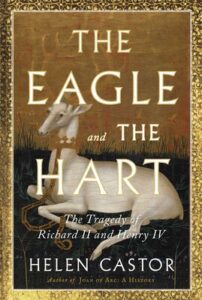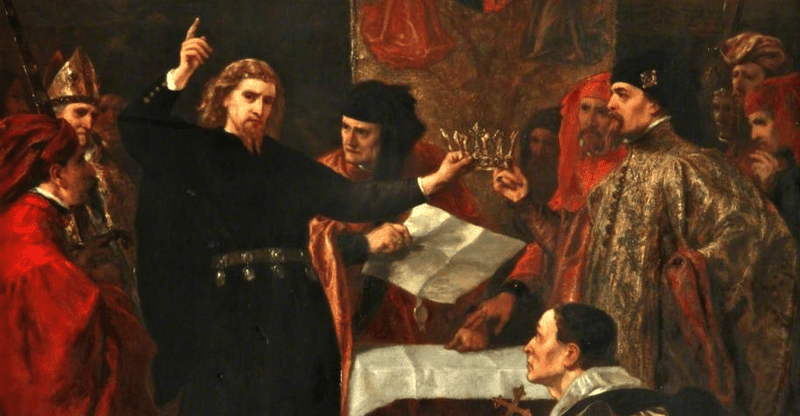Richard of Bordeaux and Henry of Bolingbroke were first cousins, born in 1367 just three months apart. They were ten years old when Richard became king of England. They were thirty-two when, in 1399, Henry overthrew him to become king in his place.
Article continues after advertisement
It was a shocking and intensely dangerous moment. The authority of the crown, contemporaries believed, was instituted by God to rule the kingdom and its people. England’s sovereign was required to be both a warrior and a judge, to protect the realm from external attack and internal anarchy. To depose the king, therefore, was to risk everything—worldly security and immortal soul—by challenging the order of God’s creation. Such devastatingly radical action could never be justified unless kingship became tyranny: rule by arbitrary will rather than law, threatening the interests of kingdom and people instead of defending them. Even then, could anyone but God rightfully remove a sovereign He had anointed?
Before Richard and Henry were born, that question had been answered in the affirmative only once in England in the 300 years since their ancestor William the Conqueror won his crown on the battlefield at Hastings. During the early decades of the fourteenth century, their great-grandfather Edward II had prioritized his favorites over the needs of his kingdom so consistently, to such appalling effect, that he undermined the rule of his own law. His wife led the resistance that, in 1327, put his son on the throne in his place.
Such devastatingly radical action could never be justified unless kingship became tyranny: rule by arbitrary will rather than law.
But Richard’s deposition in 1399 was the first in which the crown did not pass to an unequivocally legitimate heir. Richard had birthright on his side, and a profound belief in his own God-given majesty; beyond that, he lacked all qualities of leadership. Henry had everything Richard lacked, all the qualities of a sovereign, bar one: birthright. A king who was a tyrant was replaced by a king who was a usurper. In his attempt to preserve the kingdom, Henry had to undo the sacred authority of the crown and then try, somehow, to reconstruct it in his own image.
Richard and Henry are best known now through Shakespeare’s history plays. Richard II and Henry IV Parts I and II span the years from 1398 to 1413. Shakespeare himself billed Richard II as a tragedy: containing some of his most hauntingly beautiful poetry, it forms a compelling psychological study of Richard as both sovereign and man. Most of the action, the course of historical events, happens offstage.The central drama lies instead in the play of the king’s thoughts and emotions, the dismantling of his “self” as he is stripped of his power, then his crown, and finally his life.
Richard’s cousin is his nemesis, but Shakespeare offers no access into Henry’s mind. We see only the weight of the choices that confront him, and the tough pragmatism of a politician and soldier seeking to save himself and the kingdom from tyranny. It is Richard who thinks out loud, who speaks truth to this new power, and has to face what it might mean to be a king unmade. This disequilibrium—with Richard at the tragic heart of the narrative, Henry as the means of his fall—continues in different form in the plays that bear Henry’s name. There a figure scarcely recognizable as the dynamic Bolingbroke of Richard II has taken the throne as a gray man, worn almost into anonymity by rebellion and illness, who cedes center stage to his son Prince Hal, the future King Henry V, and Hal’s (largely fictional) friend Falstaff.
When the plays were written in the second half of the 1590s, almost exactly 200 years after the moment at which Richard II opens, their contemporary relevance was immediate and controversial. The great historical cycle that they completed—alongside the three parts of Henry VI and Richard III, produced earlier in the decade—frames Richard’s deposition and Henry’s usurpation as the original sin for which England’s punishment would be the darkness of civil war, a bloody conflict between the houses of Lancaster and York that ended only with the coming of the Tudors. In that reading, the aging Queen Elizabeth—by then in her sixties—embodied England’s resurrection, its triumphant return to peace and prosperity.
But The Tragedy of King Richard the Second also sets out the justification for Richard’s fall; its necessity, given the damage he was inflicting on his kingdom; and in the end its inevitability. The play depicts a capricious, childless monarch—an isolated figure surrounded by a cabal of self-interested courtiers, the succession to the throne unclear—who fails to recognize or even acknowledge the crown’s duty to its subjects. And in the 1590s that description seemed, to the disaffected among Elizabeth’s people, to describe England’s present as well as its past.
Shakespeare’s nuanced, lyrical treatment of the crisis of 1399 won popular attention and critical acclaim, but when the play was first printed in 1597, and then again twice in 1598, the provocative scene of the deposition itself was omitted from the text. In the year after that, another version of Richard and Henry’s story became both a commercial sensation and a focus of intense political scrutiny. John Hayward’s The First Part of the Life and Reign of King Henry IV appeared in February 1599, and “no book ever sold better,” its publisher noted. Hayward dedicated his history in admiring terms to the earl of Essex, once Elizabeth’s indulged favorite but now a bitterly disruptive malcontent within the regime. The queen was “mightily incensed with that book which was dedicated to my lord of Essex,” reported the lawyer Francis Bacon, “being a story of the first year of King Henry the Fourth, thinking it a seditious prelude to put into the people’s heads boldness and faction.”
In June 1599 the second edition was banned and burned as it came off the press, and in July 1600 Hayward himself was imprisoned in the Tower. The night before Essex finally took up arms in rebellion against Elizabeth in February 1601, his friends and servants arranged for a play about Richard and Henry—perhaps Shakespeare’s Richard II, perhaps a dramatization of Hayward’s book—to be performed at the Globe Theatre in London. They wanted to see it because they believed the earl would soon bring its drama “from the stage to the state,” but the revolt collapsed within hours. By the end of the month Essex had lost his head, and six months later the queen was explicit about her identification with the dead king. “I am Richard II, know you not that?” she told the keeper of the archives stored in the Tower.
Four hundred years on, after the reign of a second Queen Elizabeth, questions concerning specifically royal sovereignty—the rightful succession to the throne and the monarch’s part in defending the kingdom’s interests—lie in the realm of the politically symbolic and the passively structural. At first glance, it might seem unlikely that the crisis of 1399, so incendiary a subject in 1599, should resonate still. But the exercise of sovereign authority does not depend on the role or existence of a hereditary monarchy. The relationship between our rulers and the law, the interaction between their personalities, their principles (or lack of them), and the precedents and norms that shape our governments, remains central to the course of politics and the functioning of constitutions.
*
When I first began thinking about writing my book, The Eagle and the Hart: The Tragedy of Richard II and Henry IV, I knew it would be a study of the psychology of power. Richard and Henry make a fascinating pair—so closely related by blood, such utterly different men—whose intertwined lives formed an extraordinary and fateful moment in England’s history. But for a historian, thoughts and emotions aren’t easy to interpret without the benefit of private letters, diaries, memoirs, or any other means of access behind the closed doors of a public life.
At a distance of 600 years, drawing a psychological portrait is only made possible by joining scattered dots, rather than tracing a continuous line. I’ve set out to join dots from the surviving records of the lives of these two kings into a coherent representation of two very human beings: to investigate not only what they did, but why they did it, and how they came to be the men they were. The notes to the book show the contemporary sources from which I’ve worked. There’s plenty of room within and between them for alternative perspectives, but in the pages that follow you’ll find the Richard and the Henry I’ve come to see.
This is the story of how a nation was brought to the brink of catastrophe and disintegration—and, in the end, how it was brought back.
I also knew that, unlike some stories I’ve previously told, almost all of the book’s protagonists would be male—not only because the world of the fourteenth century took it for granted that leaders must be men, but because the moment in which Richard and Henry lived was a moment of political masculinity in crisis, a moment at which the war that had shaped the experiences of the two generations before them began to fail. Still, I hope that the women in this history won’t go unnoticed: many of them very young, some finding a kind of agency, personal or political, within a highly constrained existence, and almost all facing physical risk in childbirth just as much as their male contemporaries confronted danger on the battlefield.
What I didn’t foresee was that, during the years I’ve spent in Richard and Henry’s company, the conflict between them would come to feel so topical. To twenty-first-century eyes, the political world of the Middle Ages always combines the strange and the familiar. Fourteenth-century England was a remarkably centralized state with a complex bureaucracy, a sophisticated judicial system, and representative parliaments in which taxes were granted and statute law made—but it had no police force or standing army. The authority of the state relied instead on the private power of the aristocracy, the great landowners whose estates across the country gave them not only wealth but also control over people.
England was a nation with its own distinct language, culture, and history—but its frontiers with its neighbors of France, Scotland, and Ireland were sites of constant conflict, wars shaped by feudal hierarchies and dynastic claims. All of these circumstances gave profound significance to perceptions of legitimacy in government: the relationship between principles of law and their practical enforcement, and the balance between individual interests and the common good.
And that, for me, is what makes the tragic history of Richard II and Henry IV so chillingly resonant. Theirs is a story about what happens when a ruler demands loyalty to himself as an individual, rather than duty to the established constitution. When he seeks to create his own reality rather than concede the force of verifiable truths. When he demands that his own will should trump the rule of law. When he recognizes no interests other than his own. It’s a story about the terrifying unpredictability of unfolding political crises; about the interplay of conflicts within states and between them; about the ways in which authority can be bent, shaped, and broken. Its drama is rooted in family and dynasty, constitution and country, and its themes of power, legitimacy, and the limits of rule and resistance are as urgent now as they have ever been.
This is the story of how a nation was brought to the brink of catastrophe and disintegration—and, in the end, how it was brought back.
__________________________________

From The Eagle and the Hart: The Tragedy of Richard II and Henry IV by Helen Castor. Copyright © 2024. Reprinted by permission of Avid Reader Press, an Imprint of Simon & Schuster, Inc.

